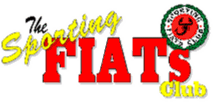Introducing
the 124 Spider Abarth
Because over a decade has passed since their last factory involvement,
it’s easy to dismiss the impact Fiat had on top level world rallying.
Cars powered by the Fiat/ Lancia Twin Cam engine and its derivatives
were at the pinnacle of world rallying competition for over 25 years.
Today the combination of Fiat and Lancia teams have still won more World
Championships than any other marque. The car that really launched them
towards this unprecedented success was the 124 Spider Abarth.
.
124
Spider Abarth History
Background
- Fiat and Abarth enter Rallying
Before the
124 Spider was introduced to rallying in 1968/1969, Fiat had been building
a service for privateers interested in rallying their cars. It was called
the Fiat Rally Service as mainly technical advice was given to veteran
cars preparing for distance and tourist events. Independently of Fiat,
Abarth provided many Italian enthusiasts with tuning components, and
their own versions of Fiats with additional performance. In the Italian
road rallies of the era Fiats proved most popular, with occasional Alfas
and the outstanding Lancia Fulvias completing the fields.And the growth
potential of this form of motorsport was apparent. From 1967 Fiat's
Rally Service was extended to provide a continuous support and
car servicing capability. So the main elements of rally support for
overseas rallies began. By 1968 a group of enthusists had formed a team
based around the Turin offices, warehouse and workshops that had once
served the Fiat racing team of the twenties.
In 1969 Fiat's attention increased. Further financial assitance lead
to a more specialised workshop, and the formation of an official team
in 1970, when Alcide Paganelli and Dominico Russo won their first Italian
rally title in a 1438cc Sport Spider.
Late in 1969
the second series of 124 Spider (we now call the 124BS) was released,
with a new 1608cc Twin Cam and twin Weber carbs, replacing the 1438cc
single carbed original. It was this car, the ‘124 Sport Spider
1600’, that provided the all round performance for rallying.
In 1970, confidence
in the cars and the team grew, as the team handled a programme involving
9 crews, participating in rallies for International Makes, European
Drivers, Italian, and Mitropa Cup Championships.
The cars involved
where the 124 Sport Spiders (in Group 4 of the International Sporting
Code), 128 Coupes and then 125S saloons (in Group 1). Some 40-plus designers
and mechanical specialists were employed.
In 1971 Fiat
entered an official factory rally team in National Rallies for the first
time. The strategy was to enter the 125S on gravel and very rough surface
rallies, while the 124 Spiders were used on tarmac and smoother gravel
events.
Then came a major change in the direction and intensity of rally efforts.
Work to homologate a rally Fiat for international use was already underway
when, in August 1971 Fiat bought the world famous Abarth & Co. tuning
firm from Carlo Abarth on his retirement. In the next few months, Abarth's
world class development efforts were channelled exclusively into rallying....
giving birth to, for instance, Osella to cater for some of Abarth's
circuit racing interests.
Abarth's expertise
in rapid designing and testing of special components reduced development
times and further energised Fiat's customer rally teams as well as their
newly formed Works team. Within 12 months Abarth's input moved competition
efforts on to a truly international basis. Under their guidance the
124 Rally was created. .
After a serious
development effort the124 Abarth Rally was launched in Autumn 1972.
This car still needed to obtain homologation for international and national
events - which was achieved in November. According to homologation inspections,
over 400 of the eventual road going versions were verified. (The manufucturer
having about 21 months to complete and sell this number of chassis).
It appears
that the standard 124 spider chassis were built up at Abarth in batches.
Under the new homologation regulations, Abarth were tasked with creating
both the Street (Stradale) versions of the 124 Rally, as well as the
Works rally cars. 124 Spider shells would be pulled off the main 124
production in one batch, for preparation at Abarth's premises. About
30 of these shells were then set aside for Works rally preparation.
The rest were prepared as road going versions (Stradale) for sale through
Fiat dealerships.
Having seen
the factory I can only suggest it was a minor miracle to have made the
400 cars for homologation by the required deadline.
Growth in the
popularity (and publicity) of rallying continued, and so1973 became
the first year of the World Championship of Rallies. In 1973 the 124
Abarth still lacked pace and reliability – Fiat loosing out to
the Renault Alpine team in the championship. Consequently the Fiat rally
effort was increased. The car was really too heavy. Over 1974 and 1975
Abarth further developed the car with stronger suspension components,
larger and better cooled brakes, wheel and tyre improvements and an
extensively lightened shell - culminating in the wide body kit version
of 1975. This final version had new ducts and a special 16-valve engine
with Kugelfischer mechanical injection. This engine was claimed to produce
over 210bhp reliably by the end of the 1975 season. The car's livery
was also changed from the initial Abarth red with black hard top, boot
and bonnet to light red with yellow trim.
History
of the 124 Abarth Rally
Pininfarina had exhibited a prototype version of the 124 Sport Spider
intended for rally competition at the 1972 Geneva Motor Show. It was
called the 124 Rally. Following on the success of the 1608cc cars in
Italian events, from 1969 the new ‘Rally’ took advantage
of the larger capacity 1756cc engines available from the Fiat 132 saloon
range.
It had been intended to launch a twin carb road version of the 124 Rally
that year but the oil crisis and resultant USA emissions regulations
affected plans. (The Weber IDF carb design intended for this project
found its way onto other cars – for instance the twin cammed Ford
Escort.)
So
no twin carb.124 Sport Spider versions were made available and the new
road going version of the 124 Spider to be badged 'Abarth' was cancelled.
We were left with just 1000 of the 124 Abarth Rally’s produced
to homologate the car for Group 4 FISA regulations rally competition.
(And some confusion remains over the actual number produced and sold).
So
the still born twin carb Sport Spider and 124 Abarth Rally were quite
different. Like other manufacturers, Fiat were required by rally regulations
to produce a large number of cars - with many parts very similar to
the actual works rally cars. The numbers of cars required varied according
to the class in which the rally car was entered in the championships,
and the verification process is called homologation. The cancelled twin
carbed 124 Sport Spider design was basically a more powerful version
of the standard road going 124, with Abarth badges.....
While the homologation 124 Abarths were produced at Abarth for two years
from 1972… including special lightweight body panels, glass fibre
boot and bonnet, roll bar, minimal bumpers and alloy door skins. The
mandatory hard top was fitted with a perspex rear window and Abarth
CD30 alloy wheels plus Recaro bucket seats were installed. The 1800cc
engine had twin 44IDF carbs, the rear axle was fully independent with
anti roll bar. From 1973 a full performance package was available to
take the road car’s 128bhp basic output to 170bhp.
|
1972 Specifications |
124
Sport Spider 1600 |
124
Sport Spider 1800 |
124
Abarth Rally |
| Cylinders / cubic capacity |
4
in line |
4
in line |
4
in line |
| Bore x Stroke (mm) |
80
x 79.2 |
84
x 79.2 |
84
x 79.2 |
| Compression Ratio |
9.8:1 |
9.8:1 |
9.8:1 |
| Camshaft &
valve configuration |
|
|
|
| Induction |
Weber 34
DMS |
Weber 34
DMS |
Weber
44 IDF 20
Weber
44 IDF 21
|
| Max Power - bhp (DIN) @ rpm |
108
@6000 |
118
@6000 |
128
@6000 |
| Volumetric output (bhp/litre
DIN) |
67.8 |
67.2 |
72.9 |
| Max torque - m.kg
(ft/ibs) @ rpm |
14 (101.2)
@4,200 |
15.6 (112.8)
@4,000 |
16.2 (117.1)
@5,200 |
| Electrical
power - generator
- battery |
|
|
|
| Transmission -
gearbox, fwd |
|
|
5
speed |
| Transmission - gear ratios
fwd |
|
|
3.66,
2.10, 1.36, 1.0, 0.88 |
| Transmission -
clutch |
215mm
single dry plate
mechanical
diaphram |
215mm
single dry plate
mechanical
diaphram
|
215mm
single dry plate
mechanical
diaphram
|
| Transmission - differential |
Crown
wheel & Pinion |
Crown
wheel & Pinion |
Crown
wheel & Pinion |
| Top speed (mph) |
112 |
115 |
118 |
| Wheelbase (mm) |
2280 |
2280 |
2280 |
| Track
- Front (mm)
- Rear (mm) |
|
|
|
| Length
(mm)
Width
(mm)
Height
(mm) |
|
|
|
| Kerb Weight (kg) |
960 |
960 |
938 |
| |
|
|
|
124 Abarth Rallying
Results
The team’s cars were winners of many events, including the European
Rally Championship, but the World Championship eluded them. This was
mainly due to another Fiat Group car… the magnificent Lancia Stratos!
The purpose-built Stratos simply overshadowed the rest of the semi-production
based designs like the 124 Abarth, heralding the future Group B rally
battles of the eighties.
The 124 Abarths were successful in winning events in 1974. The cars
seemed to be at their best on pace note events – where they could
be set up in advance of the corners – as WRC competitors do today.
The UK forest events at this time, including the RAC rally, were run
‘blind’ without the aid of pace notes. This type of event
puts at a premium on a flat torque curve and large suspension travel
– neither of which the Spider had. So the 124 Spider never did
very well in the UK events. The drivers also reported body flex and
'whip' on rougher gravel stages which can't have helped.
Without
the Stratos, 1975 would have been the title year for the 124 Abarth.
The last version of the competition cars built for the 1975 season also
had an Abarth produced 16-valve head with mechanical fuel injection
to boost competitiveness. More effort was focused on reducing body weight.
Unfortunately for the Fiat competition department, the 124 Rally lost
out to the Ferrari V6 engined Lancia Stratos (also produced within the
Fiat Group of course) as it swept all before it in the World Rally Championship
for a second season.
By 1976 Fiat had briefed Abarth to concentrate on 131 rally development
as their primary rally competition and marketing vehicle. Not before
some alternatives had been explored, such as the Prototipo 2000 X1/9
and a fundamentally re-designed 124 Abarth prototype.
The Monte Carlo Rally early in ’76 began the last season for the
last top-flight open topped rally car! (Try saying that sentence fast!)
The 131 Abarth (to achieve three titles in four years) then delivered
world championship success for Fiat.
124 Abarth Competition Specs
This information is provided as a general guide or starting point for
the cars concerned. Actual specs varied for events and as development
progressed. The road going versions could be ordered up to late 1974
from the factory.
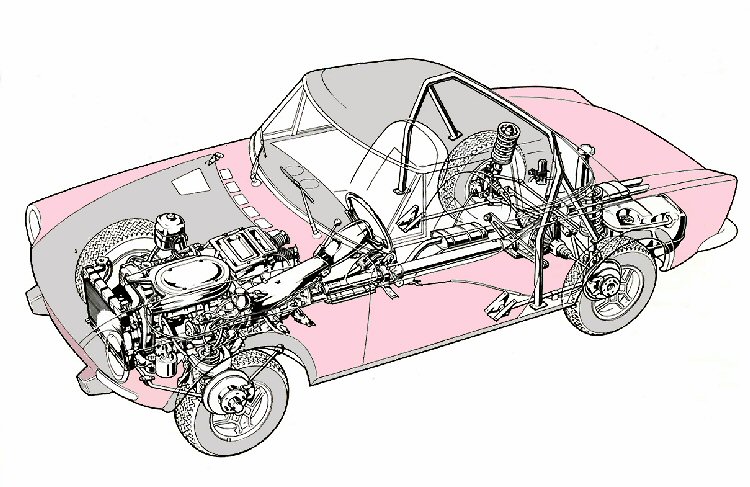
1972
Spec for the Competition Cars:
Engine
132 AC4 000 Twin Cam belt driven
4 cylinder in line, 1756cc.
9.8:1 compression
84mm bore x 79.2mm stroke
8 valve head
Output 176bhp DIN @ 6000rpm (approx. -spec varied by event)
Carburation 2x Weber 44 IDF
Ignition Electronic
Gearbox 5 speed Colotti, clutch: single dry plate
Ratios 3.667, 2.1, 1.361, 1.0, 0.881
Final Drive 10/43 ratio (varied per event) Limited Slip Differential
Suspension Front: McPherson strut type, coil springs, with upper wishbone
lower arm, anti roll bar & angled tie rods
Rear: fully independent McPherson strut type with trailing arms &
lower radius arms
Brakes Front & Rear disc
Weight 970kg dry
Wheels/tyres 13ins x 6.5j Pirelli Tyres
<124
Abarth articles>
1975 Spec for Competition Cars:
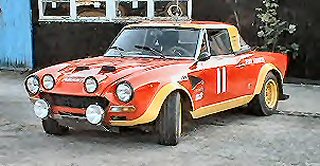
Engine 132 AC4 Twin Cam belt driven
4 cylinder in line, 1840cc.
10:1 compression
84mm bore x 83mm stroke
16 valve Abarth head
Output 190bhp DIN @ 5900rpm
Carburation Fuel Injection Kugelfischer (mechanical metering)
Ignition Electronic Marelli
Fuel Tank capacity 12.0 gals, electronic pump
Gearbox 5 speed ZF, clutch: single dry plate
Final Drive 10/43 ratio (varied per event) Limited Slip Differential
Suspension Front: McPherson strut type, coil springs, with upper wishbone
lower arm, anti roll bar & angled tie rods
Rear: fully independent McPherson strut type with trailing arms &
lower radius arms
Brakes Front: & rear disc
Weight 900kg dry
Wheels 13insx 8j Cromadora Pirelli Tyres
The
124 Abarth Stradale (Street) Version
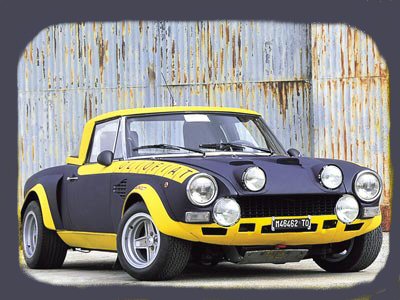
In
show room form the 124 Abarth Rally was officially available from November
1972. The power increase over the standard 124 Spider was a small 10bhp
- being quoted at 128bhp DIN at 6000 rpm.
From
1974 an Abarth kit was available, comprising camshafts carburettors
and manifiold, to raise the road going 124 Abarth's output to 150bhp
- nearer to the rally spec 175bhp). These road cars did not have the
limited slip differential but retained the competition rear suspension.
The look of the 124 Abarth was changed dramatically with black glass
fibre bonnet and boot (plus aluminium door skins), black hard top (white
optional). While the interior was finished with a revised dash,
Recaro bucket seats, and a rear roll bar.
The
wheels used were Abarth CD30 alloys and the centre 4 spoke design of
these wheels was retained by Abarth for the much wider tyres used by
the Works cars.
In terms of sports driving, the Abarth rear suspension design makes
a big difference to the stradale over the spider. While the limited
rear differential affords an opportunity to experience the true tail-out
and accelerate posture of the seventies rally car. With later versions
of the 2 litre Works engines installed I don't think its an exageration
to say that a good proportion of the scene will be viewed through the
side windows if real progress is to be maintained. Never
the most solid of chassis, the angles taken up by each corner can sometimes
best be described as interesting. I must find some quotes from the works
drivers of the era.
.
SFC
Gallery
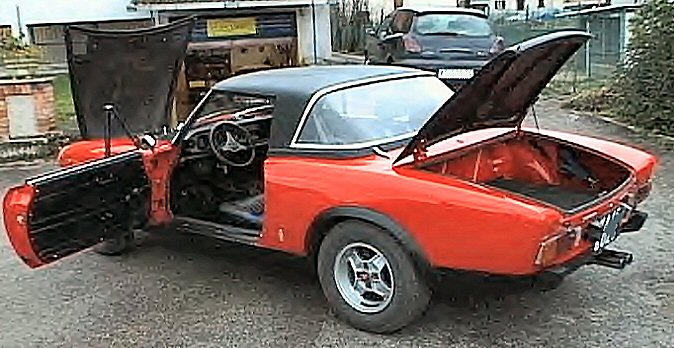
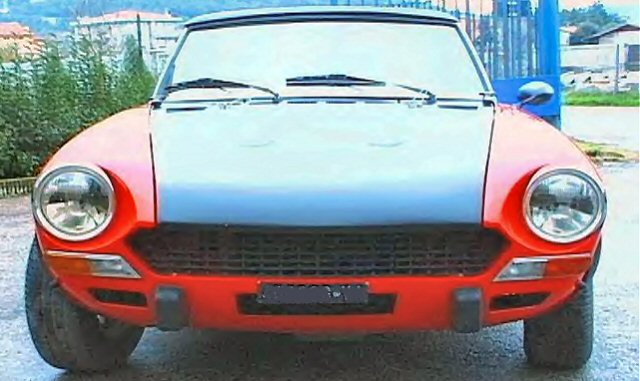
.
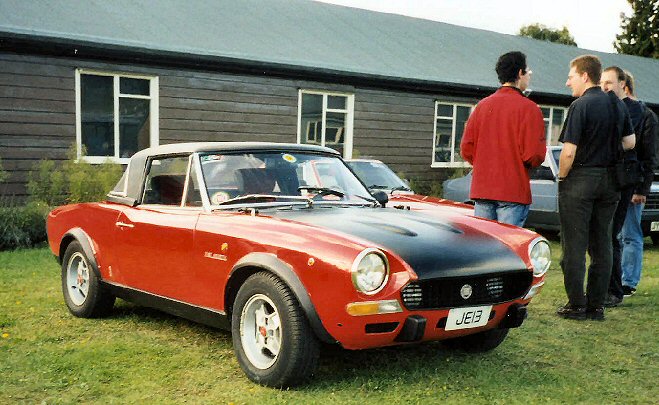
Stories
Mick’s ex - Jolly Club Car
Discovering the history of this car is a bit like researching medieval
history. It’s hard to tell fact from fiction. If you repeat a
fiction often enough it can be taken for fact.
The story is that my car, (chassis 0077244) was built up by Abarth in
1974 for the Works supported Jolly Club Rally Team. It was built to
full Group 4 spec alongside the works cars. Yet the chassis number is
late and out of sequence with the other batch numbers. This is consistent
with the story that it was built to special order.
The list of factory modifications to the car runs to about six sides
of A4, so I’ll omit it. Suffice to say the car was built to the
wide arch kit spec (although the brake ducts were later skimmed over)
full works suspension, steering brakes and electrics.
I’m confident it didn’t have the type 236b engine 16 valve
engine installed, as this would have required modifications not present
on the car. From 1976 on it could have run with a non-homologated 131
16 valve engine though. I have a photo of a works car in that spec.
The car was imported into the UK in 1980 by Vicenzo Pumo who told me
he bought it direct from the Jolly Club, and the car came with papers
to show this. It passed through a number of hands in the UK (including
reputedly living on the roof of a restaurant in Hounslow in the early
‘80’s).
As imported it was fitted with a works gravel spec engine (no. 190)
a direct drive top Collotti dog box, and a low ratio back axle (5.375:1).
With forest tyres, top speed was around 95mph at 7500 rpm, but mid range
acceleration times are ‘brisk’!
I bought the car in 1980 intending to use it as a road car with some
mild competition. By this time the car had lost its Collotti box which
may have been damaged. A test drive and inspection confirmed this car
needed quite a bit of TLC. Handling was odd over bumps, not aided by
the rear near side strut being detached from its body mount, and all
round shot bushes. The works engine was bored to its limit as was the
brakes. But the overall basic fabric was sound. And I set about the
car’s restoration.
The plan of ‘some mild competition’ took a twist when a
friend of mine, Peter Raven, took me out on the 1992 Pines Rally (Somerset).
I found myself nervously sitting in the co driver’s seat staring
up my first ever Forest Rally stage!
Nervous not only for my lack of experience but the risk to a unique
piece of rallying history!
Nothing prepared me for what was in store. It was BRILLIANT! Within
two minutes I was hooked. The first few stages involved us in finding
out how the car would handle. But as Peter got used to the car and I
got more used to what I should be doing, the times came down. We certainly
shook up the historic rallying fraternity that afternoon. By the end
of the day we had set 7 fastest stage times out of the total 16 stages.
After completing all the stages our day ended in a frustratingly familiar
manner to all Italian car owners – failure of a 70 pence electrical
component on the final non competitive road section… meaning we
had to be towed back and were disqualified!
Over the next few years the old car brought us more success and frustration
with our best result being on an incredibly rough Morgannwyg Rally in
1995. In that event we not only won the historic section outright, but
finished second overall in the ‘moderns’ including beating
a 6R4 and an Escort Cosworth!
But that event was so rough that it finally tore the car apart from
the seams. On the road back tot the finish at Swansea it was visibly
twisting over bumps and in corners. We decided to give the car an honorable
retirement, but only after a swan song in the RAC historic rally. That
decision was our undoing, as on an icy stage we slid wide and collected
a tree (on my side)!
The damage was such that it might have been more economic to build the
car into another shell- had it not been for the car’s history!
So we set about a lengthy and costly repair. Over a year and lots of
pound signs later it was all back together.
I’ve also acquired parts of a type 236b 16-valve engine from Canada
with plans to build anew. The temptation gets stronger to wheel the
old battlewagon out in its proper environment again!
124
Abarth Links
Spiderpoint
are one of the current 124 suppliers that will supply 124 Abarth parts
- often at better and more accurate quality than the originals. For
site links see the Links area below. Here's an example from their catalogue:
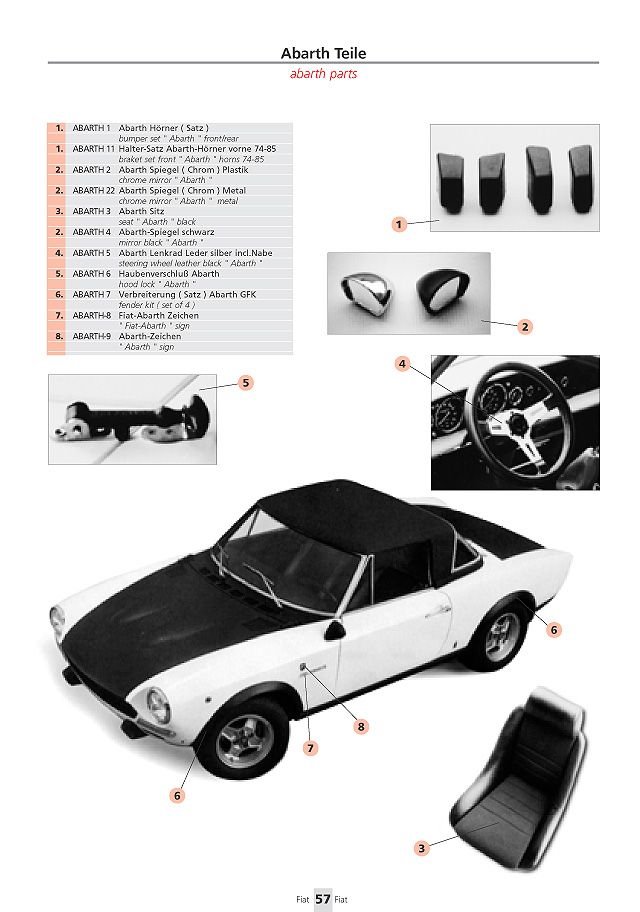
Parts
• Suspension
bushes - Superflex offer a full range for both the 124 Spider and the
Abarth http://www.superflex.co.uk/SuperFlex_Fiat_124_Prices.pdf
• Deep in the
heart of Detmold Germany is part of the Holtmann Niedergerke Group.
For the Fiat 124 in particular they carry excellent stocks of new reconditioned
and second hand spares. They should be on your shopping list. H&N
Online Shop they are in the process of extending the online spares
list here. Local retail outlet is Gettingman & Niedergerke on +49
(0)5231/6179-0. Spares for 124s, all the Dinos and many earlier Fiats
are carried too.
• Retail outlets
for H&N products include Gettingman & Niedergerke a Detmold
Company (D 32758)
• Bielstein also
supply tuning and performance items for these cars. The Bielstein brothers
can still be seen occasionally 'pedaling' their race cars around - including
a 125! Bielstein products include very nice supportive reclining and
traditional seats that can be chosen to fit right into the 124s
www.bielstein.com
Their spares
are one of the reasons for the resurgence in 124 Spider ownership in
Germany too. However they are part of the Recambi Group - who are wholesale
suppliers. Recambi will probably only supply you direct with Abarth
and Volumex parts. You will need to find the Bielstein part of the organisation
- and the brothers who started this excellent business. Telephone +49
(0)5066/3074. Email bielstein@bielstein.com
Parts
and Advice
• In London
R Proietti Ltd and associated parts
and advice .
• Middle
Barton Garage at Chipping Norton near Oxford. Specialist with modifications
and Abarth parts galore. Very much in the Abarth tradition very capable.
Also do a large catalogue for the 124 range.
• Guy
Moerenhout 'does' Abarths in a big way. And his offerings are extensive!
• Fancy Spares
stockists of obsolete Fiat parts from the 50's to the 70's. Yetminster
in Dorset. 01935 872722.
• Trentside
Classics and Sportcars from their North Lincolnshire base, offer
a complete re-build service through their network of trades and craft
based businesses. Owner Mal has always had strong Fiat connections,
and usually has several projects around at any one time. Some of these
are even sane (then again some are very interesting!) Their experience
has been partly built on keeping Dinos on the road. Anything your 124
needs they can support.
• DTR
is one of the UKs leading advisors on the 124 and London based.
• Klaus Hermann
Mayer (automotive technology GmbH) one of their specialisms is supplying
hood and frames for many of the classic soft tops and cabriolets. Several
of the Fiats are listed including the 124 Spider http://www.cabrio.de/spider.htm
. They are not as easy to talk to in English direct. Check their
site Klaus Hermann Mayer and email
on khm@cabrio.de
• Spider-Point
have established a good reputation for advice and high quality parts.
Obtain a copy of their catalogue for the 124 Spider from the Spider
Point Site . TopDrive Gmbh - the company that runs Spider-Point
also has a weekly chat if your German's up to it. Also has large catalogue
of 124 Abarth parts.
